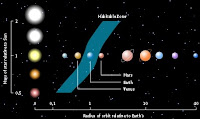 An idea came to my mind immediately after I learned that one of the rings of Saturn is being replenished by ejected material from Enceladus.
An idea came to my mind immediately after I learned that one of the rings of Saturn is being replenished by ejected material from Enceladus.What if on a distant exoplanetary system, life manages to spark and thrive within the sub-surface ocean of an Enceladus-like exomoon? And if that exomoon spews out material the same way Enceladus does, then microscopic lifeforms may get ejected along with the salty nutrients, perhaps by piggybacking on ice crystals or water droplets of the plumes. If they survive the trip outward through the vents, what comes next is fascinating: Life on Exoplanetary rings! They will then thrive off the minerals and nutrients of the rings as it is replenished by the exomoon.
We call these resilient organisms as Extremophiles. They are those that thrive in harsh environments where we don't expect life to flourish.
Do you remember the water bear that survived in outer space? Remember the recently-discovered species of bacteria that live in Earth's Stratosphere? We can almost say that with extremophiles, anything is possible! Therefore, this conjecture of life on planetary rings is worth pondering upon.
What will these "Living Exoplanet Rings" look like? Well, if it exists then it would provide a spectacular sight to behold.

Imagine a multi-colored band of rings, each band occupied by different species adapted to the properties of each ring. If this scenario happened on Enceladus, it would not just be the E-rings that would be populated by micro-organisms. As they feed, evolve and grow in size, some species would migrate to another orbit or band of ring.
And if these living ring ecosystem evolves with enough complexity, they may even pulsate, sparkle or glitter. Imagine all the colors and beauty that a "living ring" of a planet would exhibit. It would be like a flat coral reef in space. The beauty of an artificial Planetary Ring Art Installation is no match for the primeval art created by Nature and Life.
And what would these microscopic "ring organisms" look like? Well, perhaps it may look just like any other cellular lifeform but in this scenario it may develop a crytal-like structure in it's membrane to enable itself to link and separate with other crystals. Or perhaps they may exploit the ionized particles in the rings to use magnetism for 'locomotion'. I am simply postulating a mechanism by which they can increase or decrease their size and mass in order to migrate to other rings of orbit. They may utilize crystals for other purposes as well, bending and focusing light for cellular communication, and perhaps for chemical synthesis--in other words--for cooking!
I speculate that once a migration loop occurs between those thriving on the rings and those living on the exomoon, then the rate and diversity of evolution of these ring-lifeforms may be boosted, along with hastened mutations caused by cosmic rays. Those that get swept back onto the orbiting moon would reproduce to create another set of species that is already adapted to live on the planetary rings, plus some random extra qualities of the next generation. All they need to do is ride on the jet stream from the sub-surface ocean through the vents and out into space and onto the rings, and the cycle goes on.
If we further take into account the possibility that the ring organisms may eventually end up on the planet itself, then a diverse ecosystem will be created that encompasses a moon, a planet, and it's rings.
You see, the presence of life makes things a little bit more exciting. And for planetary rings, it may be true as well--even when it is within the confines of conjecture and imagination.
Links:
ESA: Sodium salts point to subsurface ocean on Enceladus




